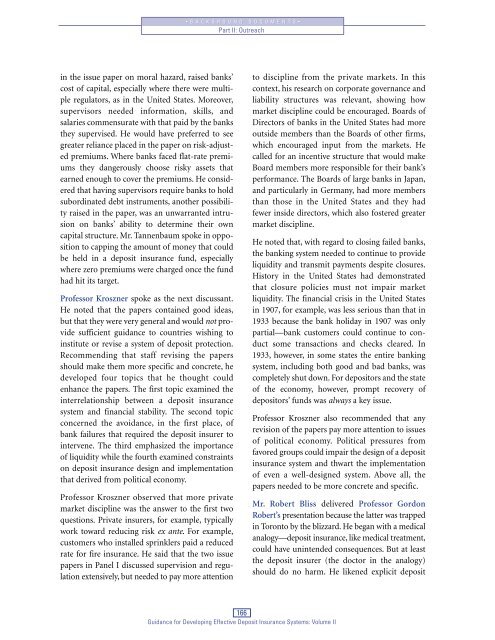Volume II - PDF - International Association of Deposit Insurers
Volume II - PDF - International Association of Deposit Insurers
Volume II - PDF - International Association of Deposit Insurers
- No tags were found...
Create successful ePaper yourself
Turn your PDF publications into a flip-book with our unique Google optimized e-Paper software.
•BACKGROUND DOCUMENTS•<br />
Part <strong>II</strong>: Outreach<br />
in the issue paper on moral hazard, raised banks’<br />
cost <strong>of</strong> capital, especially where there were multiple<br />
regulators, as in the United States. Moreover,<br />
supervisors needed information, skills, and<br />
salaries commensurate with that paid by the banks<br />
they supervised. He would have preferred to see<br />
greater reliance placed in the paper on risk-adjusted<br />
premiums. Where banks faced flat-rate premiums<br />
they dangerously choose risky assets that<br />
earned enough to cover the premiums. He considered<br />
that having supervisors require banks to hold<br />
subordinated debt instruments, another possibility<br />
raised in the paper, was an unwarranted intrusion<br />
on banks’ ability to determine their own<br />
capital structure. Mr. Tannenbaum spoke in opposition<br />
to capping the amount <strong>of</strong> money that could<br />
be held in a deposit insurance fund, especially<br />
where zero premiums were charged once the fund<br />
had hit its target.<br />
Pr<strong>of</strong>essor Kroszner spoke as the next discussant.<br />
He noted that the papers contained good ideas,<br />
but that they were very general and would not provide<br />
sufficient guidance to countries wishing to<br />
institute or revise a system <strong>of</strong> deposit protection.<br />
Recommending that staff revising the papers<br />
should make them more specific and concrete, he<br />
developed four topics that he thought could<br />
enhance the papers. The first topic examined the<br />
interrelationship between a deposit insurance<br />
system and financial stability. The second topic<br />
concerned the avoidance, in the first place, <strong>of</strong><br />
bank failures that required the deposit insurer to<br />
intervene. The third emphasized the importance<br />
<strong>of</strong> liquidity while the fourth examined constraints<br />
on deposit insurance design and implementation<br />
that derived from political economy.<br />
Pr<strong>of</strong>essor Kroszner observed that more private<br />
market discipline was the answer to the first two<br />
questions. Private insurers, for example, typically<br />
work toward reducing risk ex ante. For example,<br />
customers who installed sprinklers paid a reduced<br />
rate for fire insurance. He said that the two issue<br />
papers in Panel I discussed supervision and regulation<br />
extensively, but needed to pay more attention<br />
to discipline from the private markets. In this<br />
context, his research on corporate governance and<br />
liability structures was relevant, showing how<br />
market discipline could be encouraged. Boards <strong>of</strong><br />
Directors <strong>of</strong> banks in the United States had more<br />
outside members than the Boards <strong>of</strong> other firms,<br />
which encouraged input from the markets. He<br />
called for an incentive structure that would make<br />
Board members more responsible for their bank’s<br />
performance. The Boards <strong>of</strong> large banks in Japan,<br />
and particularly in Germany, had more members<br />
than those in the United States and they had<br />
fewer inside directors, which also fostered greater<br />
market discipline.<br />
He noted that, with regard to closing failed banks,<br />
the banking system needed to continue to provide<br />
liquidity and transmit payments despite closures.<br />
History in the United States had demonstrated<br />
that closure policies must not impair market<br />
liquidity. The financial crisis in the United States<br />
in 1907, for example, was less serious than that in<br />
1933 because the bank holiday in 1907 was only<br />
partial—bank customers could continue to conduct<br />
some transactions and checks cleared. In<br />
1933, however, in some states the entire banking<br />
system, including both good and bad banks, was<br />
completely shut down. For depositors and the state<br />
<strong>of</strong> the economy, however, prompt recovery <strong>of</strong><br />
depositors’ funds was always a key issue.<br />
Pr<strong>of</strong>essor Kroszner also recommended that any<br />
revision <strong>of</strong> the papers pay more attention to issues<br />
<strong>of</strong> political economy. Political pressures from<br />
favored groups could impair the design <strong>of</strong> a deposit<br />
insurance system and thwart the implementation<br />
<strong>of</strong> even a well-designed system. Above all, the<br />
papers needed to be more concrete and specific.<br />
Mr. Robert Bliss delivered Pr<strong>of</strong>essor Gordon<br />
Robert’s presentation because the latter was trapped<br />
in Toronto by the blizzard. He began with a medical<br />
analogy—deposit insurance, like medical treatment,<br />
could have unintended consequences. But at least<br />
the deposit insurer (the doctor in the analogy)<br />
should do no harm. He likened explicit deposit<br />
166<br />
Guidance for Developing Effective <strong>Deposit</strong> Insurance Systems: <strong>Volume</strong> <strong>II</strong>
















